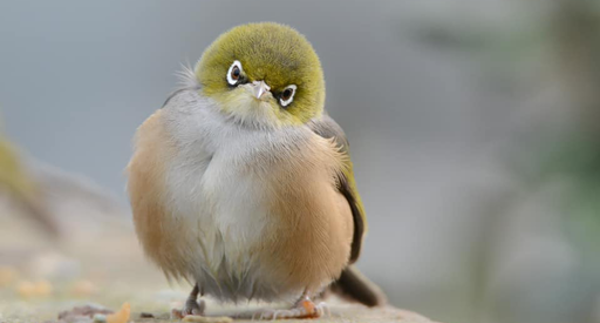
Photo credit: Trish and Chris
In New Zealand we are lucky to enjoy the beauty and song of a range of wild birds. Discover the plants and food sources that will encourage our favourite native birds to your backyard.
Over the winter months when food is most scarce for birds, a garden with a good supply of winter flowers and berries will attract our feathered friends.
Tui, bellbird and kereru are known to travel large distances in search of flowers and fruit.
Insect eating birds such as fantails and silvereyes commonly build nests in the branches of tall shrubs, so they are out of reach of predators.
Learn how to set up a wild bird café
Follow our guide to attracting wild birds into your garden with feeding stations and plants.
Wild Bird GuideTui
Beautiful and territorial, tui bring plenty of birdsong to the garden.
- Feeds on: Nectar feeder. Nectar of Flax, Kowhai and Pohutukawa, also feeds on sugar water from nectar feeders. A pollinator of many plants, feeds on insects. Important seed disperser for native trees.
- What to plant: Pohutukawa, Kowhai, Harakeke (Flax), Puriri.
- Nests: September to January. Nests are made of sticks and grasses in a tree fork or dense shrub.
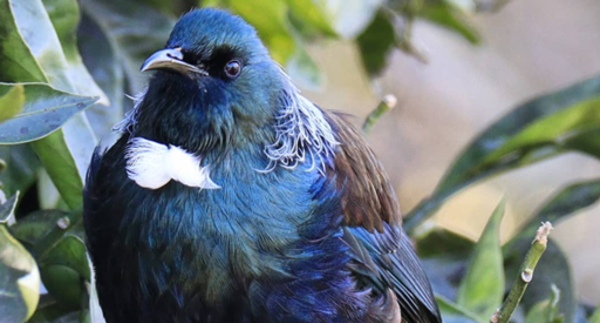
Photo credit: Beck @beckjmcd
Fantail (Pikwakawaka)
Flits around the garden chasing insects with a distinctive cheeping.
- What to plant: Manuka, Kanuka (Leptospermum species), Coprosma, Muehlenbeckia, Hebe, Olearia.
- Feeds on: Insect feeder. Feeds on grubs, spiders and flying insects. Often seen following farm animals and humans chasing insects that have been disturbed.
- Nests: August to March in the North Island, September to January in the South. Nests are made of fine grasses, lichen, moss and small pieces of bark bound with cobwebs. Can raise two or more broods a year.
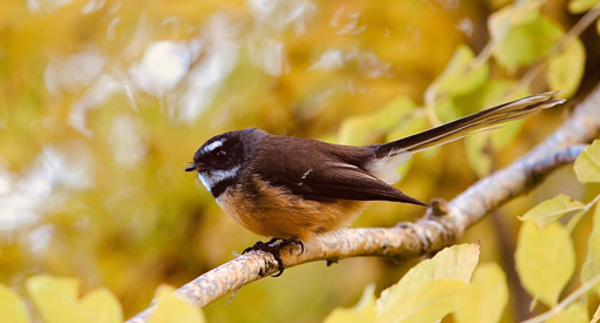
Photo credit: Brooke
NZ Wood Pigeon (Kereru)
A handsome bird that swoops low to get berries and fruit, makes a cooing sound.
- What to plant: Karaka, Puriri, Guava, Kowhai, tree lucerne, Makomako (Wineberry), Tawa, Titoki, Nikau, native Fuchsia, Kahikatea.
- Feeds on: Berries and fruit of many native and exotic trees and shrubs. The only bird that can swallow the large berries of Karaka and Puriri trees. Feeds on shoots, flowers and leaves when berries are not available. Important seed disperser as they fly long distances.
- Nests: Builds flimsy nests of sticks in the forks of trees, they lay one egg with the male and female taking turns to sit on it.
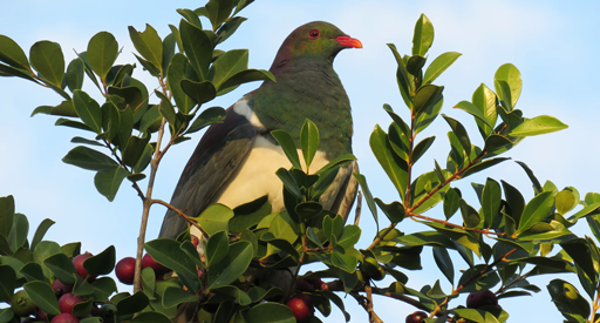
Photo credit: Kylie
Silvereye/waxeye (Tauhou)
Silvereye or waxeye are a self-introduced species of bird (1800’s) and so are protected in New Zealand as a native. The Maori name is Tauhou which means “stranger” or “new arrival”. They make a chirping sound as they flit around the garden.
- What to plant: Kowhai, Pohutukawa, Puriri, Rewarewa, Rata, Harakeke (Flax), Coprosma, Makomako (Wineberry), Feijoa, Callistemon (Bottlebrush), Fuchsia, Banksia, Eucalyptus (gum trees).
- Feeds on: Nectar and insects. They have a brush shaped tongue for nectar feeding. Caterpillars, spiders, flies, beetles. Berries from native trees such as coprosma. Also feeds from nectar feeders and eats fat from bird feeders.
- Nests: August to February in pine trees, Kahikatea, Totara, Rimu, Bamboo. Nests are made with lichen, moss, cobwebs, fine grasses.
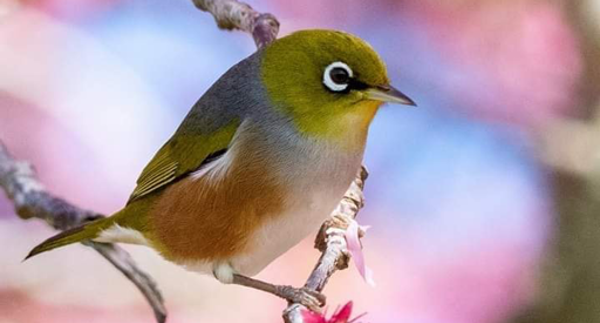
Photo credit: Cara
Bellbird (Korimako)
Makes a chiming bell-like sound. Mainly seen North of Auckland, on a few offshore islands, common in the Coromandel area.
- What to plant: Kowhai, Pohutukawa, Fuchsia, Rata, Harakeke (Flax), Puriri provides a year-round food source in warmer regions.
- Feeds on: Nectar / honey feeder. Feeds on nectar of Kowhai, Harakeke (Flax), Rata, Pohutukawa flowers. In autumn it feeds on fruit and insects.
- Nests: September to January. Raises two broods per year in a nest of twigs, leaves and grasses hidden in dense trees and foliage.
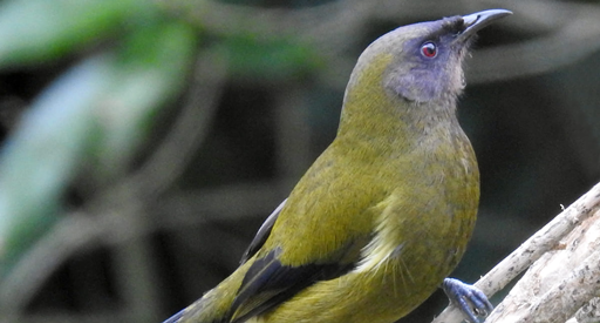
Photo credit: Mel
Less common native birds you may be lucky enough to sight.
- Morepork (Ruru) a night owl that feeds on large insects such as weta, cicadas, beetles, moths, spiders, rats, mice, small birds and lizards. Nests in hollow trees, stumps and branches. Plant Cabbage Trees.
- New Zealand Kaka (Kaka) a greenish-brown parrot with a hooked bill, perfect for feeding on flowers, nectar and berries, as well as insects such as huhu grubs. Nests in cavities of large trees.
- New Zealand Parakeet (Kakariki) a bright green parrot with a red head, rare on the mainland, found on offshore islands. Feeds on flax seeds, tussock, grasses, fruit, nectar and flowers. Sometimes eats insects. Nests in hollow trees where branches have fallen away.
Post a comment
Common Native NZ Birds Comments
Plant Banksia. I know it's not a native, but it draws in the Tui from April to October. This is because it has such a long flowering season. We have two among our native trees. The Tui enjoy the Pohutukawa, Kowhai and Rewarewa in their brief flowering times. But it is the Banksia that keeps them coming all through winter.
Dennis Martin